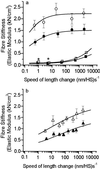Mutation of the myosin converter domain alters cross-bridge elasticity
- PMID: 11904418
- PMCID: PMC122562
- DOI: 10.1073/pnas.062415899
Mutation of the myosin converter domain alters cross-bridge elasticity
Abstract
Elastic distortion of a structural element of the actomyosin complex is fundamental to the ability of myosin to generate motile forces. An elastic element allows strain to develop within the actomyosin complex (cross-bridge) before movement. Relief of this strain then drives filament sliding, or more generally, movement of a cargo. Even with the known crystal structure of the myosin head, however, the structural element of the actomyosin complex in which elastic distortion occurs remained unclear. To assign functional relevance to various structural elements of the myosin head, e.g., to identify the elastic element within the cross-bridge, we studied mechanical properties of muscle fibers from patients with familial hypertrophic cardiomyopathy with point mutations in the head domain of the beta-myosin heavy chain. We found that the Arg-719 --> Trp (Arg719Trp) mutation, which is located in the converter domain of the myosin head fragment, causes an increase in force generation and fiber stiffness under isometric conditions by 48-59%. Under rigor and relaxing conditions, fiber stiffness was 45-47% higher than in control fibers. Yet, kinetics of active cross-bridge cycling were unchanged. These findings, especially the increase in fiber stiffness under rigor conditions, indicate that cross-bridges with the Arg719Trp mutation are more resistant to elastic distortion. The data presented here strongly suggest that the converter domain that forms the junction between the catalytic and the light-chain-binding domain of the myosin head is not only essential for elastic distortion of the cross-bridge, but that the main elastic distortion may even occur within the converter domain itself.
Figures





Similar articles
-
Cardiomyopathy mutations reveal variable region of myosin converter as major element of cross-bridge compliance.Biophys J. 2009 Aug 5;97(3):806-24. doi: 10.1016/j.bpj.2009.05.023. Biophys J. 2009. PMID: 19651039 Free PMC article.
-
Structural features of cross-bridges in isometrically contracting skeletal muscle.Biophys J. 2002 May;82(5):2536-47. doi: 10.1016/S0006-3495(02)75597-5. Biophys J. 2002. PMID: 11964242 Free PMC article.
-
Isometric tension and mutant myosin heavy chain content in single skeletal myofibers from hypertrophic cardiomyopathy patients.J Mol Cell Cardiol. 1997 Feb;29(2):667-76. doi: 10.1006/jmcc.1996.0309. J Mol Cell Cardiol. 1997. PMID: 9140824
-
Functional consequences of mutations in the myosin heavy chain at sites implicated in familial hypertrophic cardiomyopathy.Trends Cardiovasc Med. 2002 Nov;12(8):348-54. doi: 10.1016/s1050-1738(02)00181-0. Trends Cardiovasc Med. 2002. PMID: 12536121 Review.
-
Evolutionary significance of myosin heavy chain heterogeneity in birds.Microsc Res Tech. 2000 Sep 15;50(6):473-91. doi: 10.1002/1097-0029(20000915)50:6<473::AID-JEMT5>3.0.CO;2-R. Microsc Res Tech. 2000. PMID: 10998637 Review.
Cited by
-
Mechanical and kinetic properties of β-cardiac/slow skeletal muscle myosin.J Muscle Res Cell Motil. 2012 Dec;33(6):403-17. doi: 10.1007/s10974-012-9315-8. Epub 2012 Jul 31. J Muscle Res Cell Motil. 2012. PMID: 22847802
-
Multidimensional structure-function relationships in human β-cardiac myosin from population-scale genetic variation.Proc Natl Acad Sci U S A. 2016 Jun 14;113(24):6701-6. doi: 10.1073/pnas.1606950113. Epub 2016 May 31. Proc Natl Acad Sci U S A. 2016. PMID: 27247418 Free PMC article.
-
Cardiac ventricular myosin and slow skeletal myosin exhibit dissimilar chemomechanical properties despite bearing the same myosin heavy chain isoform.J Biol Chem. 2022 Jul;298(7):102070. doi: 10.1016/j.jbc.2022.102070. Epub 2022 May 24. J Biol Chem. 2022. PMID: 35623390 Free PMC article.
-
Nebulin plays a direct role in promoting strong actin-myosin interactions.FASEB J. 2009 Dec;23(12):4117-25. doi: 10.1096/fj.09-137729. Epub 2009 Aug 13. FASEB J. 2009. PMID: 19679637 Free PMC article.
-
Prolonged space flight-induced alterations in the structure and function of human skeletal muscle fibres.J Physiol. 2010 Sep 15;588(Pt 18):3567-92. doi: 10.1113/jphysiol.2010.188508. Epub 2010 Jul 26. J Physiol. 2010. PMID: 20660569 Free PMC article.
References
-
- Rayment I, Holden H M, Whittaker M, Yohn C B, Lorenz M, Holmes K C, Milligan R A. Science. 1993;261:58–65. - PubMed
-
- Lowey S, Waller G S, Trybus K M. Nature (London) 1993;365:454–456. - PubMed
-
- Whittaker M, Wilson-Kubalek E M, Smith J E, Faust L, Milligan R A, Sweeney H L. Nature (London) 1995;378:748–751. - PubMed
-
- Dominguez R, Freyzon Y, Trybus K M, Cohen C. Cell. 1998;94:559–571. - PubMed
Publication types
MeSH terms
Substances
LinkOut - more resources
Full Text Sources

